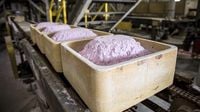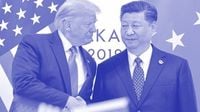China’s decision to suspend its sweeping export controls on rare earths and other critical materials has sent ripples through global markets, signaling a significant—if perhaps temporary—thaw in the tense trade relationship between Beijing and Washington. The move, announced on Friday, November 7, 2025, by China’s Ministry of Commerce, comes as part of a broader trade truce following a high-profile summit between Chinese President Xi Jinping and US President Donald Trump in Busan, South Korea, just days earlier. The suspension is set to last until November 10, 2026, offering a year-long reprieve for industries worldwide that rely heavily on these strategic resources.
Rare earth elements, though often invisible to the average consumer, are the backbone of modern technology. They’re essential for manufacturing everything from electric vehicles and smartphones to advanced military equipment like fighter jets and missile guidance systems. According to AFP, the controls that China suspended had been unveiled just a month prior, in October 2025, and would have restricted exports of products containing even trace amounts of certain rare earths. These restrictions didn’t just threaten to disrupt supply chains—they risked upending the entire global market for high-tech manufacturing.
The suspension, formalized in a joint statement from China’s Ministry of Commerce and its customs agency, pauses the implementation of six sets of export control regulations that had been issued on October 9. As The New York Times reports, these rules would have barred the transfer out of China of rare earth processing equipment, battery manufacturing equipment, and certain super-hard materials crucial for making semiconductors, solar panels, and armor-piercing ammunition. The regulations were set to be rolled out in stages through December 1, 2025, but now find themselves on ice for at least a year.
What prompted this abrupt policy reversal? The answer lies in the high-stakes diplomacy that unfolded at the Busan summit. The two leaders, Xi and Trump, reached a framework for a trade deal that included the expectation that China would delay the imposition of its strict new rare earth export licensing regime by a year. According to Reuters, President Trump declared after the meeting, “All of the rare earth [issue] is settled, and that’s for the world. There’s no roadblock from China anymore.” While that may sound a bit optimistic, the sentiment reflects the relief felt by many in the global business community.
The White House chimed in with its own interpretation of the agreement, stating that China had agreed to issue “general licenses” for shipments of rare earth materials to the US. This, officials said, amounted to the “de facto removal” of export controls imposed since 2023. The licenses would also cover four other critical materials: gallium, germanium, antimony, and graphite—each vital to various high-tech and green energy industries. However, as The New York Times notes, China’s Ministry of Commerce has not clarified how long these licenses will last or what information companies must provide when applying for them, leaving some uncertainty lingering in the air.
Industry leaders and government officials in the West have not been shy about describing the potential impact of China’s rare earth controls. Scott Bessent, the US Treasury Secretary, famously likened the October 9 export controls to “a bazooka at the supply chains and the industrial base of the entire free world.” He wasn’t exaggerating: China processes nearly the entire world’s supply of rare earth elements, and its dominance in this arena gives it enormous leverage. The rules would have affected not just direct exports from China, but also the manufacture outside of China of any products containing even small amounts of Chinese rare earths.
Still, the picture is not entirely rosy for Western manufacturers. The suspension announced on Friday does not address a separate, earlier round of export controls imposed by China on April 4, 2025. Those measures targeted seven kinds of rare earths and the powerful magnets made from them. Since then, China has required overseas companies to provide a daunting amount of technical information to obtain six-month licenses for even small quantities of restricted rare earths. More critically, China has barred any export of these rare earths for military applications—a move that has already begun to slow the production of military equipment in the West and hampered Europe’s ability to supply Ukraine with arms amid Russia’s ongoing invasion.
China’s position in the rare earth market is, quite simply, dominant. As The New York Times points out, many companies involved in the extraction and processing of these minerals are partly or wholly owned by the Chinese government, and China has consistently tilted toward Russia during the Ukraine conflict, buying Russian raw materials and selling industrial equipment to Moscow. The current suspension of export controls, while a welcome relief for many, leaves unresolved the fundamental question of how the world can diversify away from such overwhelming Chinese control.
Companies outside China remain wary. For months, non-Chinese mines and refineries have complained that Chinese suppliers have been unwilling to sell them vital equipment, even as the world’s appetite for electric vehicles, wind turbines, and other green technologies continues to grow. The uncertainty around the duration and conditions of China’s new general licenses only adds to the anxiety. If the past few years have taught global manufacturers anything, it’s that relying on a single supplier—especially one with a history of wielding its market power for political leverage—is a risky proposition.
In a gesture that seems designed to further ease trade tensions, China’s General Administration of Customs also announced on Friday that it was reinstating the right of three American companies to ship soybeans to China and would allow US exports of logs to China to resume. These steps, while minor compared to the rare earths decision, signal a broader willingness on Beijing’s part to dial down the economic hostilities—at least for now.
As the November 2026 deadline approaches, all eyes will be on the next moves from both Beijing and Washington. Will the suspension be extended, or will the threat of new export controls return? For now, the world’s manufacturers, defense contractors, and green tech companies can breathe a little easier—though no one is likely to let their guard down completely. The rare earths saga, it seems, is far from over.


